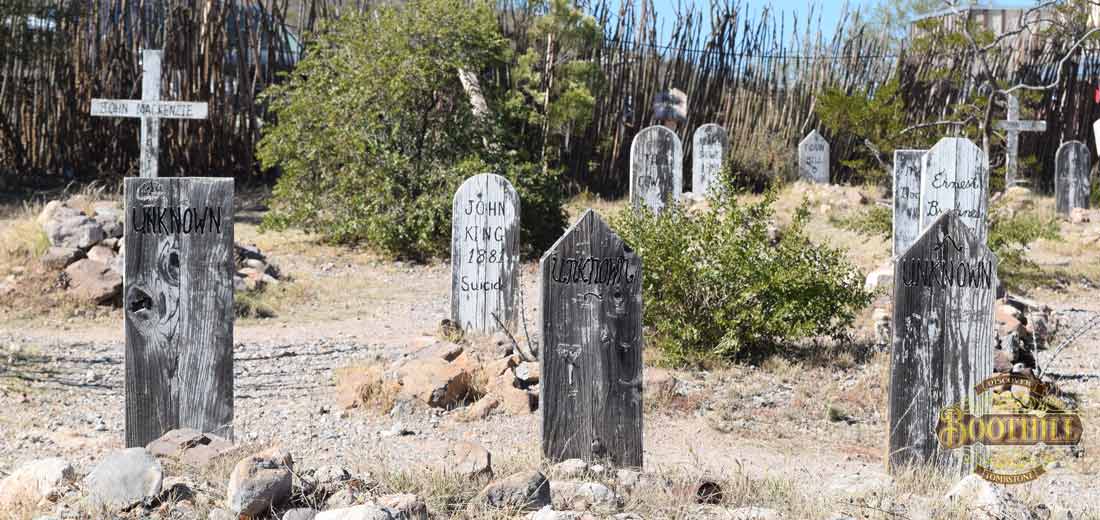


408 N. Highway 80, Tombstone, AZ 85638 ~ 520-457-1450 ~ Open Daily 8am - 6pm ~ $6 Admission
408 N. Highway 80, Tombstone, AZ 85638 ~ 520-457-1450 ~ Open Daily 8am - 6pm ~ $6 Admission
408 N. Highway 80, Tombstone, AZ 85638 ~ 520-457-1450 ~ Open Daily 8am - 6pm ~ $6 Admission

BOOTHILL CEMETERY
by Don Taylor
City of Tombstone Historian
 As one drives into Tombstone on Highway 80, visitors are greeted by Tombstone’s cemetery known today as “Boothill.” This was actually the third cemetery used by the early citizens of Tombstone. Unfortunately we do not have any official records of this City Cemetery; however we have a “layout” from a City map drawn by the City Surveyor named Kelleher. It shows a plot with sections labeled “A-L,” with roads cut through the sections. One curious note is that there is no section “J.” To date we have not found the reason for this exclusion. This burial ground, by 1884, was full. A new, and current cemetery, was established in 1885 on land donated to the City of Tombstone by John Escapule on the “Old Contention Road” west of town. With a new graveyard available, several locals moved their family from the original internment plot to the new cemetery. They didn’t want their loved ones final resting place to be near the outlaws and scoundrels in this cemetery. In 1889 a blurb in the Tombstone Prospector newspaper indicated that most of the wooden markers were worn so badly that one could not read them. It also said that many had completely weathered away. Masonic records indicate that they referred to this cemetery as “the old boneyard.”
As one drives into Tombstone on Highway 80, visitors are greeted by Tombstone’s cemetery known today as “Boothill.” This was actually the third cemetery used by the early citizens of Tombstone. Unfortunately we do not have any official records of this City Cemetery; however we have a “layout” from a City map drawn by the City Surveyor named Kelleher. It shows a plot with sections labeled “A-L,” with roads cut through the sections. One curious note is that there is no section “J.” To date we have not found the reason for this exclusion. This burial ground, by 1884, was full. A new, and current cemetery, was established in 1885 on land donated to the City of Tombstone by John Escapule on the “Old Contention Road” west of town. With a new graveyard available, several locals moved their family from the original internment plot to the new cemetery. They didn’t want their loved ones final resting place to be near the outlaws and scoundrels in this cemetery. In 1889 a blurb in the Tombstone Prospector newspaper indicated that most of the wooden markers were worn so badly that one could not read them. It also said that many had completely weathered away. Masonic records indicate that they referred to this cemetery as “the old boneyard.”
In 1919 a man named Frederick Bechdolt visited Tombstone to research magazines articles he would publish in “The Saturday Evening Post” about Tombstone’s early years. He met Arlington, Arlie, Gardner, the Secretary of The Commercial Club and the two hit it off. In 1923 Bechdolt started a movement to preserve this resting place for Tombstone’s pioneers, and to call it “Boot Hill.” The idea and the name took hold. Soon after this effort to save this integral piece of Tombstone’s history, U.S. 80 was completed which connected Tombstone with the rest of the nation via a paved thoroughfare. Using Bechdolt’s compilation book, “When the West Was Young;” Walter Noble Burns’ “Tombstone: an Iliad of the Southwest” and “Helldorado: Bringing Law to the Mesquite” by William Breakenridge, Tombstone established a new industry, tourism. Today, hundreds of thousands of visitors come to Tombstone. Boot Hill is either the first place they stop, or the last site they visit on their way home. Like the City of Tombstone, Boot Hill is filled with history and legends.